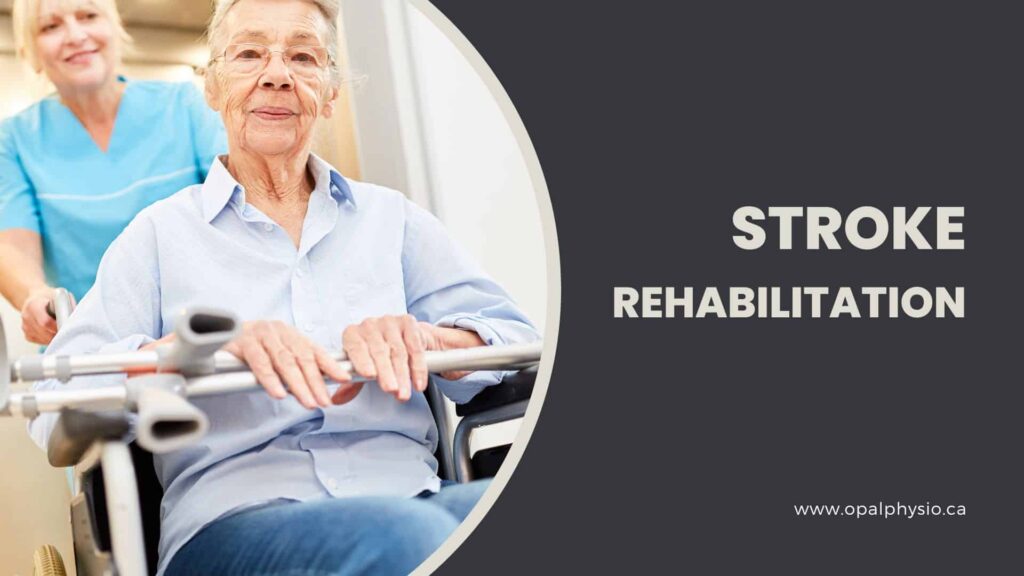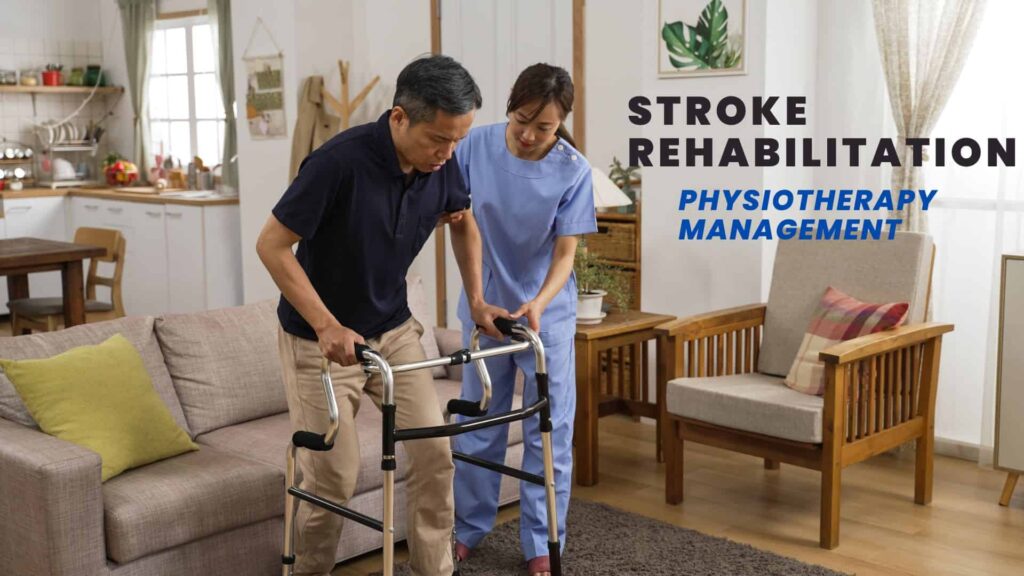Stroke Rehabilitation in Langley
A stroke is a devastating event that can drastically impact an individual’s physical, cognitive, and emotional well-being. While medical intervention is crucial in the immediate aftermath of a stroke, long-term rehabilitation is often necessary to help individuals regain lost function and improve their quality of life.
One key component of stroke rehabilitation is physiotherapy, which plays a crucial role in helping individuals rebuild their strength, mobility, and overall functional abilities.
At Opal Physiotherapy Clinic, we understand the challenges faced by individuals who have experienced a stroke. Our dedicated and experienced physiotherapists are committed to providing personalized and effective stroke rehabilitation programs to help you regain your independence and improve your quality of life.

What is a Stroke?
A stroke occurs when there is damage to the brain caused by a lack of oxygen, blockage or rupture of a major artery supplying blood to the brain. This causes a reduction in blood supply to the area from the blocked artery. It leads to damage to cells in that area of the brain. There are different types of strokes; each type requires a different approach to therapy based on the symptoms.
- Ischemic stroke: blood supply is interrupted by a clot that blocks an artery.
- Hemorrhagic stroke: bleeding into the brain damages the tissue
- Subarachnoid hemorrhage: bleeding outside the brain parenchyma causes swelling around the brain stem
- Transient ischemic attack (TIA): symptoms occur without permanent injury to the brain.
In Canada, approximately 878,500 adults aged 20 and older have experienced a stroke, with 438,700 men and 439,800 women affected, according to national data from 2017-18. One-quarter of Canadians with stroke are under 65, and stroke risk increases rapidly after age 55.
Signs and symptoms of a stroke
Signs and symptoms usually develop within minutes of the onset of a stroke.
- Sudden weakness in the face, arm or leg on one side of your body.
- Speech may become slurred.
- Loss of sense of taste or smell.
Other signs include
- Numbness or tingling around your mouth or tongue,
- Difficulty swallowing,
- Dizziness or loss of balance,
- Blurred vision,
- Headache,
- Confusion or memory problems.
What is stroke rehabilitation?
Stroke rehabilitation is a program of therapies designed to help you relearn skills lost after a stroke. Depending on the parts of your brain affected by the stroke, rehabilitation can help with movement, speech, strength, and daily living skills.
A stroke can result in physical disabilities and cognitive impairments. Neurological physiotherapy is integral to stroke rehabilitation to help you regain strength, mobility, coordination and balance. It involves exercises, education and advice to maximize your ability to optimal function.

Physiotherapy for stroke rehabilitation
Starting physiotherapy as soon as possible is important when you have a stroke. Neurological physiotherapy for stroke aims to help you regain as much movement and function as possible.
Our approach
Our approach to stroke rehabilitation is focused on repetitive actions — practicing the same thing repeatedly. Your rehabilitation plan will depend on the body part or type of ability affected by the condition.
Our stroke physiotherapy rehabilitation program focuses on the following:
Bobath-based approach to treatment
Our physiotherapists use the Bobath approach in conjunction with other treatments to provide the best possible outcome for the patient.
Bobath therapy is based on the brain’s ability to adapt to change, reorganize, and recover after neurological damage.
This treatment approach is tailored to each patient’s neurological condition, and the core of this therapy involves training patients to learn specific movement patterns according to their needs.
The Bobath approach is goal-oriented and task-specific, aiming to organize the internal (proprioceptive) and external (exteroceptive) environment of the nervous system for the efficient functioning of the individual.
It is an interactive process between patients and therapists, focusing on the following aspects:
Assessment: A thorough analysis of each patient’s functional skills, muscle tone, reflexes, balance, posture, movement patterns, and sensory perception.
Goal setting: Based on the assessment, the physiotherapist sets realistic and meaningful goals for the individual. These may include improving motor skills, enhancing balance, increasing strength, reducing muscle tone, or facilitating functional activities such as walking, eating, dressing, and transferring.
The therapeutic intervention: involves hands-on facilitation by the physiotherapist, who guides the patient’s movements to promote and discourage abnormal movement patterns. The patient is actively involved in the therapy, and the focus is on problem-solving and learning through experience.
Sensory-motor learning: The Bobath approach emphasizes sensory-motor learning, where the patient learns or relearns motor skills through practice and feedback. The physiotherapist uses various techniques to facilitate this learning, such as positioning, weight shifting, and tactile cues.
The Bobath approach is flexible and adaptable, allowing for progression and changes as the individual’s condition and abilities change. The choice of approach is guided by the individual’s needs, preferences, and the current best evidence.
Services offered
Our stroke physiotherapy rehabilitation services include:
- Gait and balance training
- Muscle strengthening and conditioning exercises
- Adaptive equipment recommendations and training
- Home exercise program development and progression
- Family/caregiver education and support
Benefits of stroke Physiotherapy rehabilitation
Our comprehensive stroke rehabilitation program can help you
- Improve muscle strength and coordination
- Enhance balance and mobility
- Increase independence in daily activities
- Reduce the risk of falls and injuries
- Promote overall well-being and quality of life
Factors affecting the outcome of stroke rehabilitation
Stroke recovery varies from person to person. It’s hard to predict how many abilities you might recover and how soon. In general, successful stroke rehabilitation depends on physical factors, emotional factors, social factors, and therapeutic factors.
When to begin stroke rehabilitation
The sooner you begin stroke rehabilitation, the more likely you will regain lost abilities and skills. It’s common for stroke rehabilitation to start as soon as 24 to 48 hours after your stroke. Once your condition has stabilized and you can be at home, ongoing intervention is crucial because the brain can often start to recover quickly soon after a stroke. This early period is an optimal time to start relearning lost skills.
At our clinic, we offer outpatient therapy for stroke rehabilitation. You can live at home and come to our clinic for treatment. This approach allows you to recover in your home while still receiving the necessary professional care and support.
Duration of stroke rehabilitation
The duration of stroke rehabilitation depends on the severity of your stroke and related complications. Some stroke survivors recover quickly, but most need some form of long-term stroke rehabilitation, possibly lasting for months or years after their stroke.
Our stroke rehabilitation team
Our stroke rehabilitation team comprises specialists, including physiatrists, physical therapists and kinesiologists.
At Opal Physiotherapy, your treatment will be tailored to your individual needs, depending on the type and severity of your stroke. It may include:
- Exercises to improve movement and coordination
- Training to improve your balance
- Muscle stimulation to help reduce muscle stiffness
- Soft tissue release to help reduce muscle tension
- Breathing exercises to improve your lung function
Our team will deliver your physiotherapy treatment and work with you to develop a personalized rehabilitation program.
We aim to help you regain as much independence as possible. It may take several months or even years of rehabilitation, but most people recover well with the help of physiotherapy.
